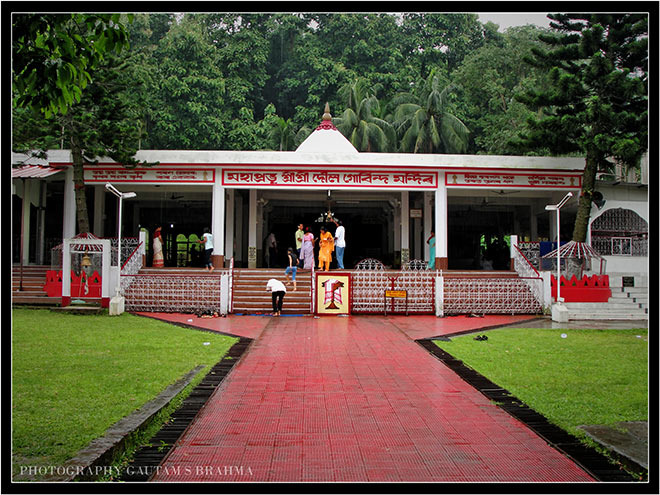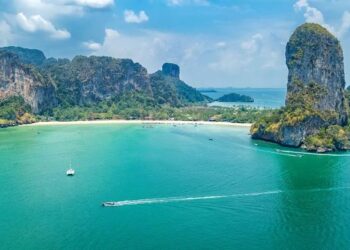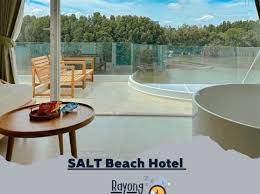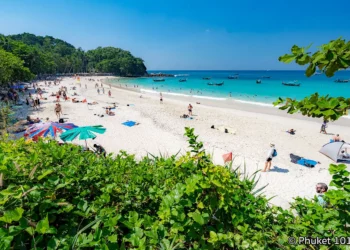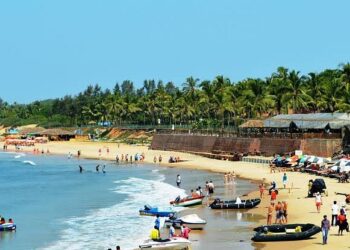Located at the base of Chandrabharati Hill, on the northern bank of the Brahmaputra River in North Guwahati, Assam, the Doul Govinda Temple is a famous Vaishnavite shrine dedicated to Lord Krishna. The temple is easily reached by a short ferry ride from central Guwahati. As one of the important Krishna temples in Assam, it represents the deep-rooted Vaishnava traditions of Hinduism.
History of Doul Govinda Temple
The Doul Govinda Temple has a history of more than 150 years, with its first structure believed to have been built sometime in the mid-19th century. Later, in 1966, the temple was repaired and renovated with public support under a trust, helping it keep its sacred value while improving needs. It is said that the idol of Lord Krishna was brought from Sandhyasar near Nalbari by Ganga Ram Barooah, who began the regular prayers and rituals here. The temple is now looked after by a committee of about 25 members. It shows the religious growth that took place in Assam after the Ahom period, when Vaishnavism spread widely along with local customs. Old stories and inscriptions from the area also tell of the temple’s long importance as a center of faith in Kamrup district.
Architecture of Doul Govinda Temple
The Doul Govinda Temple shows a mix of old Assamese style and some modern touches in its design. Built mainly with stone and brick, it was made to last in the region’s humid weather. Inside the main sanctum stands a black stone idol of Lord Krishna, worshipped as Doul Govinda. During the daily worship, the idol is dressed in bright clothes, decorated with scented flowers, jewels and ornaments offered by the devotees. The temple has a dome-shaped roof with a small kalasha placed on top, and from here one can see the flow of the Brahmaputra River. Inside the premises, there is also a Namghar, the traditional Assamese prayer hall, where people gather for singing hymns and prayers together. The outside walls carry simple carvings of floral shapes and divine forms, showing a plain design rather than rich decoration.
Legends of Doul Govinda Temple
Legends linked with the temple speak of the unusual and sacred way the idol of Lord Krishna was chosen. As local people tell, Ganga Ram Barooah found two idols at Sandhyasar, one old and another newly formed. When there was doubt about which idol should be placed on the festival chariot during Holi, the priest prayed for a sign from the Lord. The next morning, the new idol was found to have moved forward by about four fingers, which everyone took as a divine message. After this, the new idol was installed as Doul Govinda, while the older one due to being damaged, was kept aside.
Worship and Practices at Doul Govinda Temple
The worship at Doul Govinda Temple follows the Vaishnavite tradition, focusing deeply on devotion to Lord Krishna. Every morning around 7 AM, the priest begins the rituals by bathing the idol with milk and water, after which archana is performed with the chanting of sacred names and offering of flowers, fruits, and incense. In the afternoon, bhoga or sacred food is prepared and later shared among devotees as prasad.
All forms of worship in the temple follow peaceful and non-violent customs, as animal sacrifice is strictly avoided in line with Vaishnava beliefs of purity and kindness. Near the main temple is the Namghar, where devotees come together for communal prayers and sing hymns that mix Vedic chants with traditional Assamese folk tunes.
Festivals
The temple is well-known for its lively Krishna-centered festivals, attracting large numbers of pilgrims. The biggest festival here is Doul Utsav (Holi), held in February–March. The festival is marked with colorful processions, folk dances with drums and cymbals, small cultural performances, and the throwing of gulal (colored powder). During this time, extra ferries run from Guwahati, which adds to the lively feeling.
Janmashtami, in August, celebrates Lord Krishna’s birth and is observed with prayers that go on through the night, fasting, and decorating the temple and idol beautifully. Other occasions like Maghi Purnima and Dol Purnima see lamps lit and devotional songs along the river.
How to Get There
Air: Lokpriya Gopinath Bordoloi International Airport in Guwahati, about 27 km away, connects to Delhi (2 hours) and Kolkata (1 hour). Taxis to Fancy Bazaar Ferry Ghat take 30–40 minutes, followed by a 10-minute ferry ride to Rajaduar.
Train: Guwahati Railway Station, 7 km from the ferry ghat, links to Delhi and Dibrugarh (8 hours). Autos or taxis to the ghat require 15–20 minutes.
Road: From Guwahati city center (12 km), take buses or taxis to Fancy Bazaar, then a ferry across the Brahmaputra. Local autos from Rajaduar ghat cover the 5-minute walk to the temple. Special festival ferries run frequently.
Best Time to Visit
October to March is the best period to visit, with pleasant temperatures around 15–25°C, making it comfortable to climb up to the temple and enjoy the riverside views. Holi, in February–March, is the most festive time, but the crowds can be very large, sometimes 5,000–10,000 people. For a quieter experience, weekdays are better, and early mornings between 7–9 AM are ideal for darshan with the morning mist adding to the atmosphere. The monsoon months, June–September, are not recommended because high river levels can disrupt ferry services. The temple stays open daily from 7 AM to 8 PM.
Nearby Attractions
Dirgheswari Temple: 4 km away, a Shakti Peetha on Dirgheswari Hill with cave sanctum and Durga idol, known for Durga Puja.
Aswakranta Temple: 2–3 km away, an ancient Shiva shrine with rock carvings and legends of sage Markandeya.
Kamakhya Temple: 12 km south across the river, Assam’s premier Shakti Peetha on Nilachal Hill, site of Ambubachi Mela.
Umananda Temple: 10 km away, a Shiva temple on Peacock Island, reachable by boat for serene Brahmaputra views.
